Armed Forces of Belarus
| Armed Forces of the Republic of Belarus | |
|---|---|
|
Узброеныя сілы Рэспублікі Беларусь (Belarusian) Вооружённые силы Республики Беларусь (Russian) | |
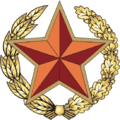 Symbol of the Ministry of Defence of the Republic of Belarus | |
| Current form | 1992 |
| Service branches |
Ground Forces[1] Air Force Special Forces of Belarus Transport Troops |
| Headquarters | Minsk |
| Leadership | |
| Commander-in-chief | President Alexander Lukashenko |
| Minister of Defence | Lieutenant-General Andrei Ravkov |
| Chief of the General Staff | Major-General Oleg Belokonev |
| Manpower | |
| Active personnel | 62,000 [2][3] |
| Reserve personnel | 344,750 |
| Deployed personnel | 4,560 (Around the borders)[4] |
| Expenditures | |
| Budget | ~€560 million (2018)[5] |
| Percent of GDP | 1.2% (2018) |
| Industry | |
| Foreign suppliers |
|
| Related articles | |
| Ranks | Military ranks of Belarus |
The Armed Forces of the Republic of Belarus (Belarusian: Узброеныя сілы Рэспублікі Беларусь – УС РБ, Uzbrojenyja siły Respubliki Biełaruś, Russian: Boopyжённыe cилы Pecпyблики Бeлapycь, Vooruzhennye sily Respubliki Belarus) consist of the Ground Forces and the Air and Air Defence Forces, all under the command of the Republic of Belarus Ministry of Defence. Being a landlocked country, Belarus has no navy.
In 2017 the IISS estimated that personnel in the armed forces numbered 48,000. Most soldiers are conscripts serving for a period of 18 months, although there is an alternative service option.[6]
The previous Belarusian National Republic of March 1918 to 1919 did not have time to create armed forces in its brief existence, although attempts to create a military have been documented.[7] The Republic of Belarus has conducted effective military reforms within the last decade which have reshaped its armed forces as a relatively effective force for a small state in somewhat difficult economic conditions.[8]
History
Until 1991 the Soviet Belorussian Military District comprised the 5th Guards Tank Army (HQ Bobruisk), the 7th Tank Army (HQ Borisov), the 28th Army (HQ Grodno), the 120th Guards Motor Rifle Division, the 72nd Guards District Training Center and logistical units and formations. In addition to these troops Belarus was host to centrally controlled formations, namely the 103rd Guards Airborne Division, the 38th Guards Airborne Brigade, the 11th Air Defence Corps of the 2nd Air Defence Army, the 26th Air Army and also units and formations of the Strategic Rocket Forces, Long Range Aviation, the Navy and special forces.
In late 1991 the 5th Guards Tank Army comprised the 30th Guards Motor Rifle Division, newly arrived from Czechoslovakia, and the 193rd Tank Division, plus two armament and equipment storage bases (the former 8th Guards and 29th Tank Divisions), and army troops. The 7th Tank Army comprised the 3rd Guards Tank Division, 34th, and 37th Guards Tank Divisions, plus army troops. The 28th Army comprised four divisions, one of which was a low-status mobilisation division. Also arriving from the Southern Group of Forces in Hungary was the 19th Guards Tank Division.
On September 20, 1991 the Supreme Soviet of Belarus passed resolution "On the formation of the Armed Forces of the Republic of Belarus" and on January 11, 1992 resolution "On the Armed Forces deployed in the territory of the Republic of Belarus." On March 18, 1992 the parliament passed resolution "On the Armed Forces of the Republic of Belarus" that bound the government "to start the formation of the Armed Forces of the Republic of Belarus as of March 20, 1992" and "to submit to the Supreme Soviet for approval the suggested structure of the Armed Forces, their size and order of their material and technical supplies".
On May 6, 1992 the Belorussian Military District was abolished. The Belarusian Ministry of Defence and the Main Staff were formed from its resources.[9] The former first deputy commander and military district Chief of Staff, Lieutenant-General P P Kozlovskiy, was appointed Minister of Defence on 22 April 1992, taking over from acting Minister of Defence Colonel-General Petr Chaus.
On November 3, 1992, Belarus passed the law "On the Armed Forces of the Republic of Belarus" defining the status, structure and guiding principles of the Armed Forces.[10] After the introduction of presidency the law was amended twice: on September 4, 1996 and on November 9, 1999 but on the whole the law retains its initial contents.
On January 1, 1993 all service personnel on Belarusian soil were required to either take an oath of loyalty to Belarus, or leave. This oath however did not alleviate concerns regarding loyalty to Russia in time of crisis, especially since nearly 50% of all military personnel were ethnically Russian at the end of 1992.
In June 1995, President Lushenko issued a decree on the Mobile Forces. By June 1996, they comprised a headquarters in Vitebsk, two brigades drawn from the 103rd Guards Airborne Division, the 38th Independent Mobile Brigade (Brest, Belarus), an air transport regiment, and communications, logistics, and engineer units.[11]
Membership in the Commonwealth of Independent States, as well as the 1996 treaty on the Union of Russia and Belarus and the Treaty of the Formation of a Union State in 1999, confirmed a close partnership with Russia. Much of the air defence system is integrated into the Russian air defence network, and in 2006 the two nations signed an agreement on the creation of a unified air defence system.[12]
Structure
Belarus government websites say that the Ministry of Defence of the Republic of Belarus is supported by Central Command Support Elements and the General Staff of the Armed Forces.[13] Combat Support Elements of the Armed Forces included Reconnaissance, Electronic Warfare, Signals, Engineer, NBC Defence, Navigation and Topography, and Maintenance organisations. Logistic Elements of the Armed Forces provided Material Support, Logistic Support, Medical Support, Veterinarian Support, and Military Construction.
In 1995 the Military Academy of Belarus was set up on the basis of two military educational institutions – the Minsk Air Defence and Rocket School of the Soviet Air Defence Forces and the Minsk Higher Military Command School. Its 10 departments train officers of 38 specialties for practically all arms of service. Also in 1995 it was given the status of a government institution of secondary special military education for young men.
Belarus Ground Forces
The Library of Congress said that in 1994 Belarus had ground forces of 52,500.[14] They were organized into three corps headquarters, two motor divisions, one airborne division, the 51st Guards Artillery Division at Osipovichi,[15] three mechanized divisions, one airborne brigade, three surface-to-surface missile brigades,[16] two antitank brigades, one special duties brigade, and seven anti-aircraft missile brigades. Equipment included 3,108 main battle tanks (seventy-nine T-54, 639 T-55, 291 T-62, 299 T-64, eight T-80, and 1,800 T-72), 419 medium-range launchers, sixty surface to-surface missiles, and 350 surface-to-air missiles.
In 1993 the 7th Tank Army was reorganised as the 7th Army Corps. In 1994 the 7th Army Corps was redesignated as the 65th Army Corps, still located at Borisov.
By January 1, 1995, the composition of the Belarusian ground forces had changed.[14] The Library of Congress estimated at the time that Ministry of Defence forces included the 103rd Guards Airborne Division and the 38th Separate Assault-Landing Brigade; the 28th Army Corps (Grodno Region and Brest Region), composed of headquarters at Grodno, the 6th Separate Mechanised Infantry Brigade, the 11th Guards Mechanised Infantry Brigade, the 50th Separate Mechanised Infantry Brigade, the Armament and Equipment base, and corps units (missile troops, antiaircraft, chemical and engineer troops, signals, and rear services); the 65th Army Corps (Minsk and Vitebsk Regions), composed of headquarters at Borisov, three armament and equipment bases, and corps units; and the 5th Guards Army Corps (Minsk and Mahilyow regions) made up of headquarters at Babruysk, the 30th Separate Motor Rifle Brigade, two Armament and Equipment bases, and corps units.
Actually, the 103rd Guards Airborne Division had been reorganized as Headquarters, Mobile Forces, in 1993. On 1 August 1996 the 51st Guards Artillery Division was reorganised as the 51st Guards Central Group of Artillery, still located at Osipovichi.[17]
On 21 December 2001, a major reorganisation of the Ground Forces produced two operational-territorial commands, formed from two former corps headquarters.[18] All Belarus ground forces were now grouped within these two commands, the Western Operational Command at Grodno, former from the previous 28th Army Corps, the former Soviet 28th Army, and the North Western Operational Command, the former 65th Army Corps, at Barysaw (Borisov).
Since about 2001, territorial defence forces, which as of 2002 number around 150,000, have been forming, organised into battalions, companies, and platoons spread across Belarus.[18]
In 2007, the Land Forces consisted of 29,600 soldiers (6th Guards Mechanised Brigade (Grodno), 11th Guards Mechanized Brigade at Slonim, the 120th Guards Mechanised Brigade (Minsk), 38th and 103rd Mobile Brigades (organized similarly to Soviet airborne regiments, not all of them are equipped with BMD-1),[19] 5th Spetsnaz Brigade (Maryina Horka),[20] five artillery brigades and four regiments, two MRL regiments, 15th, 29th, 115th, 120th and 302nd SAM Brigades, two SSM brigades, two brigades and one regiment of engineers, 8th independent NBC Brigade, two signals brigades, 40th independent NBC battalion. Army equipment includes 1800 main battle tanks (MBT) and 2600 AFV/APC. The weapons and equipment storage bases include the 50th (Brest), 19th,[21] 34th & 37th (former tank divisions), 3rd, and 28th (Baranovichi). Weapons storage bases that have been disbanded include the 29th, 30th, 193rd, and the storage base that used to be the 8th Guards Tank Division at Marina Gorka.
In 2012, it is reported that there are six mechanised brigades in the Ground Forces: three full-strength, the 6th (Grodno), 11th (Slonim), and 120th Guards Mechanised Brigade at Minsk. The others were at reduced strength, where there was one battalion, the 19th (Zaslonova), 37th, and 50th (Baranovichi).[22] By 2017, the number of mechanised brigades had been further reduced to four, with two at full strength and two at reduced strength.[6]
Air Force and Air Defence Forces
In 2007 the Air Force and Air Defence Force of Belarus (AF & ADF) consisted of 18,170 personnel (two fighter/interceptor bases, four FGA/reconnaissance squadrons, one transport air base, training aircraft, and attack and support helicopters, SAM units). Air Force equipment included in 2004 260 fighter-ground attack/training aircraft and 80 attack helicopters. According to Belarus government websites, the Air Forces now have two commands, the Western Operational-Tactical Command and the North-Western Operational-Tactical Command.
The 61st and 927th Air Bases have now merged into the 61st (fighter) Air Base at Baranovichi, flying MiG-29s, and the 206th Air Base (Ross) has merged into the 116th Guards Assault Air Base at Lida, flying Su-25s.
Internal Troops
The Internal Troops were formed from the former Soviet Internal Troops after the collapse of the Soviet Union. They consist of three independent brigades and seven independent battalions (consecutively numbered). Among the Internal Troop formations is the 3rd Red Banner separate special purpose Brigade (V/Ch 3214, located in Minsk, in the district Uruchcha, "Uruchenskaya Brigade").[23] This brigade performs crowd control, combating terrorism tasks, and can assist border guards in case of complications. In addition, the brigade has been training for combined arms operations in the event of armed conflict. It was formed in the 1990s on the base of the 334th Regiment of the 120th 'Rogachev' Guards Motor Rifle Division.[24]
Military Commandants
The military commandants of the Armed Forces of Belarus are regional administrations tasked with overseeing Belarusian regiments in the commantant's territory. Units are assigned to a specific commandant based on their location. There are 6 military commandants in the Belarusian Armed Forces.[25]
| Commandant Name | Commander | Region |
|---|---|---|
| Baranavichy Military Commandant | Lieutenant Colonel Vladimir Pivovar | Brest Region |
| Babruysk Military Commandant | Lieutenant Colonel Vladimir Gritsuk | Mogilev Region |
| Barysaw Military Commandant | Lieutenant Colonel Ivan Kislyi | Minsk Region |
| Brest Military Commandant | Lieutenant Colonel Yuri Ivanyuk | Brest Region |
| Grodno Military Commandant | Lieutenant Colonel Alexander Lupyrev | Grodno Region |
| Minsk Military Commandant | Colonel Nikolai Kurash | Minsk Region |
Manpower
The Government Directive of 20 March 1992 ‘On the Establishment of the Armed Forces of the Republic of Belarus’ founded the Belarusian army. The Soviet troops of the BMD were smoothly converted into Belarusian military units. Yet one of the first tasks of the Belarusian government was a reduction in its numbers. 240,000 soldiers and officers were serving in the Belarusian Military District. By early 2013 the numbers of military personnel had been scaled down nearly fourfold since 1991. In February 2014, Belorusskaya Voyennaya Gazeta, the official publication of the Ministry of Defense revealed that the Belarusian Armed Forces contains about 59,500 personnel, including 46,000 soldiers and 13,000 civilians.[26]
Equipment
The military forces of Belarus are almost exclusively armed with Soviet-era equipment inherited from the Soviet Union. Although large in numbers, some Western experts consider some of it outdated.
“The Belarusian armed forces receive around 100 brand-new and upgraded systems a year,” said in late July 2018, Belarusian Deputy Minister of Defence for Armament and Chief of Armament Major General Sergei Simonenko.[27] The MBTs are of Russian type T-72, T-62, and T-55, the APCs and IFVs are of Russian type MT-LB, BMP-2, BMP-1, and the BMD-1, and Russian type trucks are the GAZ-66 and the KAMAZ-6560. The Air Force is equipped with MiG-29 fighters, Su-25 bombers, as well as Mi-8, Mi-24, and some old, Polish built Mi-2 helicopters. In December 2005, Belarus bought 10 L-39C jet trainer aircraft from the Ukraine, and in 2017 a contract have been signed to buy 12 Su-30SM fighters.[28] In 2006, four batteries (divizions in Russian terminology; about 6 systems each) of S-300 anti-aircraft systems were acquired from Russia to reinforce the Joint CIS Air Defense System.
Tanks
| Model | Image | Origin | Type | Number | Notes |
|---|---|---|---|---|---|
| T-72 | .jpg) |
Main Battle Tank | 446 | Mainly T-72B version. Four mechanized brigades.[29] Some upgraded to the B3M level.[30] | |
| T-80 | 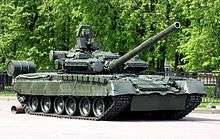 |
Main battle tank | 69[31][29] | T-80B Version. | |
Infantry Fighting Vehicles
| Model | Image | Origin | Type | Number | Notes |
|---|---|---|---|---|---|
| BMP-1 | 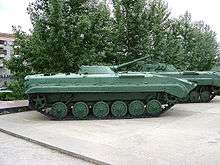 |
Infantry Fighting Vehicle | 136[29] | BRM-1 version [29] | |
| BMP-2 | Infantry Fighting Vehicle | 875[29] | Four mechanized brigades.[29] | ||
Armored Personal Carrier
| Model | Image | Origin | Type | Number | Notes |
|---|---|---|---|---|---|
| BTR-70 | 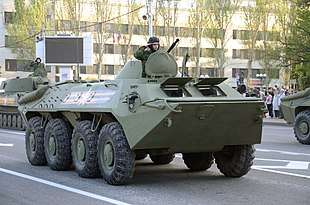 |
Armoured personnel carrier | 39[29] | In Special Forces. Upgraded BTR-70MB1. | |
| BTR-80 | _(cropped).jpg) |
Armoured personnel carrier | 153[29] | In Special Forces. | |
| MT-LB | .jpg) |
Armoured personnel carrier | 50[29] | ||
Artillery
| Model | Image | Origin | Type | Number | Notes |
|---|---|---|---|---|---|
| Multiple rocket launcher | |||||
| BM-21 Grad |  |
Multiple rocket launcher | 126[29] | Partially upgraded to BM-21A "Belgrad". | |
| BM-27 Uragan |  |
Self-propelled artillery | 72[29] | ||
| BM-30 Smerch | 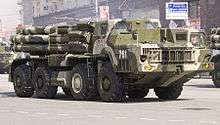 |
Multiple rocket launcher | 36[29] | ||
| Polonez (MRL) | .jpg) |
Multiple rocket launcher | 4[29] | ||
| Tactical ballistic missile | |||||
| OTR-21 Tochka |  |
Tactical ballistic missile | 38[32] | ||
| Scud | Tactical ballistic missile | 60[29] | |||
| Self-propelled artillery | |||||
| 2S1 Gvozdika | 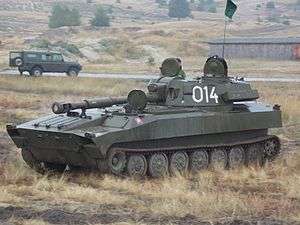 |
Self-propelled artillery | 198[29] | ||
| 2S3 Akatsiya |  |
Self-propelled artillery | 108[29] | ||
| 2S5 Giatsint-S | 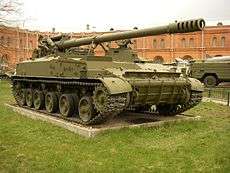 |
Self-propelled artillery | 116[29] | ||
| 2S9 Nona | 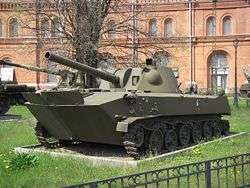 |
Self propelled mortar | 48[29] | ||
| 2S19 Msta | 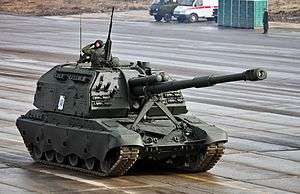 |
Self-propelled artillery | 12[29] | ||
| Towed Howitzer | |||||
| 122 mm howitzer 2A18 (D-30) | 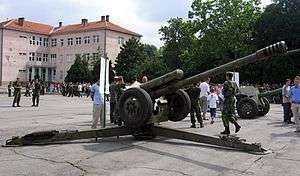 |
122mm Towed Howitzer | 48[29] | ||
| 152 mm howitzer 2A65 |  |
152 mm Towed Howitzer | 48[29] | ||
| 152 mm gun 2A36 | .jpg) |
152 mm Towed Howitzer | 132[29] | ||
Air Defence
| Model | Image | Origin | Type | Number | Notes |
|---|---|---|---|---|---|
| 2K22 Tunguska (SA-19 Grison) | .jpg) |
Tracked SPAAW | - | ||
| 9K33 Osa (SA-8 Gecko) |  |
6×6 amphibious SAM system | 24 batteries | ||
| 9K35 Strela-10 | .jpg) |
Vehicle-mounted SAM system | 350 | ||
| Tor missile system | .jpg) |
Tracked SAM system | 8 | 4 ordered[33] | |
| S-300PS (SA-10 Grumble) S-300V (SA-12 Giant/Gladiator) |
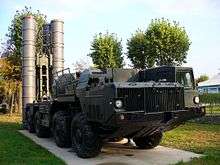 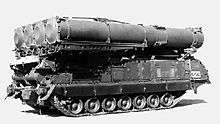 |
Long-range SAM system | 12 12 |
S-300PS systems delivered from Russia in 2007 to replace older S-300 model in Belarusian inventory.[34] Four divisions of S-300 missiles to be delivered in 2014.[35] | |
| 9K37 Buk (SA-11 Gadfly) | Medium range SAM system | 12 | |||
| S-400 missile system | 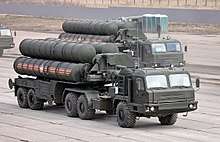 |
Long-Range Mobile surface-to-air missile system | 2 Batteries | Announced their intentions to purchase the S-400 in September 2011.[36] Deliveries will start in 2015 (official statement).[37][38] 2 systems in 2016.[39] | |
Other
- Dongfeng EQ2058s
- Lis-PM
- MZKT-490100
- Dajiang CS/VN3 Drakon[40]
- Burevestnik-MB armed drone
- Busel-MB reconnaissance drone[41]
- BRDM-2
- armed robot Centaur[42]
- 2B23 Nona-M1 semi-automatic breech-loading 120 mm towed mortars
- Sopka radar station[43]
Military Academies
- Minsk Suvorov Military School
- Belarusian Military Academy
- Belarusian State Medical School
References
- ↑ "Сухопутные войска Республики Беларусь - Армия Беларуси". belarmy.by. Retrieved 6 April 2018.
- ↑ "В белорусской армии служит 62 тысячи человек". Retrieved 23 December 2014.
- ↑ "Armed forces - Belarus". Retrieved 23 December 2014.
- ↑ John Pike. "Ground Forces". Retrieved 23 December 2014.
- ↑ https://www.tv3.lt/m/naujiena/936490/neutrali-baltarusija-ispudingai-didina-savo-karini-biudzeta
- 1 2 "The Military Balance 2017". The Military Balance. International Institute for Strategic Studies. 117: 203–204. 2017 – via Taylor and Francis. (Subscription required (help)).
- ↑ Selected Bibliography of works on the struggle for Belarusian Independence 1900–1921 in the Francis Skaryna Belarusian Library in London Archived 2013-09-27 at the Wayback Machine.
- ↑ Dr Steven J Main, The Belarusian Armed Forces: A Military-Political History 1991–2003 Archived 2008-03-06 at the Wayback Machine., Conflict Studies Research Centre, RMA Sandhurst, 2003. This is the definitive work in English on the recent history of Belarus's armed forces.
- ↑ I N Rodionov, ed, Belorusskiy voyennyy okrug, Military Encyclopedia, t1, "Voyennoye izdatel'stvo", Moscow, 1997, 422, cited in Main, 2003, 6.
- ↑ Pavel Bykovsky & Alexander Vasilevich, Military Development and the Armed Forces of Belarus, Moscow Defence Brief, CAST, 2007
- ↑ Richard Woff, 'Minsk: making limited progress with reform,' Jane's Intelligence Review, June 1996, 248.
- ↑ Russia, Belarus to sign agreement on joint air defence system, RIA Novosti via GlobalSecurity.org, 19 October 2006.
- ↑ "Ministry of Defence of RB - News". Archived from the original on 2 May 2006. Retrieved 23 December 2014.
- 1 2 Library of Congress Country Studies, Ground Forces, in A Country Study: Belarus, June 1995
- ↑ Feskov et al. 2004, 53, with five artillery brigades and two independent battalions.
- ↑ Including the 43rd (OTR-21 Tochka) and 76th (8 НУ 9КЛг) Rocket Brigades at Zaslonovo, probably.
- ↑ Soldat.ru, Brigades of the Belarus Armed Forces, accessed December 2012.
- 1 2 Main, 2003
- ↑ http://www.ryadovoy.ru/forum/index.php/topic,406.0.html Archived 2012-04-17 at the Wayback Machine.
- ↑ Formed Maryina Gorka, Minsk Oblast, 1 January 1963as the 5th Special Forces Brigade GRU. Two battalions. On 3.4.78 renamed 5th independent Special Forces Brigade GRU. Took the oath of allegiance to Belarus on 31 December 1992. Michael Holm, 5th independent Special Forces Brigade, accessed 2014.
- ↑ One of the equipment storage bases is the 19th, the former 19th Guards Tank Division at Zaslonovo in the Lepiel region. On October 1, 2003, the base was considerably strengthened. From other bases of storage of arms and techniques now we are distinguished favorably by new structure. Besides a battalion of protection, storage and service, motor-rifle and tank battalions were added. "Archived copy". Archived from the original on 2008-05-13. Retrieved 2008-02-10. .
- ↑ Vad777
- ↑ See https://charter97.eu/en/news/2008/11/17/12125/?1
- ↑ Ryadovoy.ru, "Archived copy". Archived from the original on 2012-05-13. Retrieved 2011-11-06.
- ↑ http://www.mil.by/ru/forces/vkvs/
- ↑ "ВООРУЖЕННЫЕ СИЛЫ РЕСПУБЛИКИ БЕЛАРУСЬ НА СОВРЕМЕННОМ ЭТАПЕ РАЗВИТИЯ — Во славу Родины". vsr.mil.by (in Russian). Retrieved 2018-01-14.
- ↑ https://www.janes.com/article/82220/belarus-re-arms-airborne-troops
- ↑ "On the purchase of Su-30SM for the Belarusian Air Force". 20 June 2017. Retrieved 23 July 2018.
- 1 2 3 4 5 6 7 8 9 10 11 12 13 14 15 16 17 18 19 20 21 22 International Institute for Strategic Studies (IISS) (9 February 2016). "The Military Balance 2016". The Military Balance. Routledge. 116: 181–183. doi:10.1080/04597222.2016.1127558.
- ↑ http://www.armyrecognition.com/june_2017_global_defense_security_news_industry/belarus_introduces_first_t-72b3m_in_its_army_80606171.html
- ↑ Pike, John. "Belarus Army Equipment". www.globalsecurity.org. Retrieved 6 April 2018.
- ↑ Military Balance 2016, p. 101
- ↑ "Third battery of Tor-M2 air defense missile system enters in service with the Belarus army". January 4, 2014.
- ↑ "Russia completes S-300PS deliveries to Belarus". articles.janes.com. 14 June 2006. Retrieved 7 August 2011.
- ↑ Russia will deliver four divisions of S-300 ground-to-air defense missile systems to Belarus - Armyrecognition.com, 24 April 2013
- ↑ "Kazakhstan to get first S-400 air defense systems after 2015". En.tengrinews.kz. 2013-03-15. Retrieved 2013-10-29.
- ↑ Денис Тельманов. "ПВО России и Белоруссии получит С-400 и цифровое управление". Известия.
- ↑ "Россия установит в Белоруссии ракетные системы С-400 "Триумф"". KM.RU Новости – новости дня, новости России, последние новости и комментарии.
- ↑ "Россия поставила Белоруссии две зенитных ракетных системы С-400". rns.online. 28 June 2016. Retrieved 6 April 2018.
- ↑ https://www.armyrecognition.com/july_2018_global_defense_security_army_news_industry/belarus_parades_new_armored_vehicles_on_independence_day_military_parade_2018.html
- ↑ https://www.armyrecognition.com/july_2018_global_defense_security_army_news_industry/local-made_burevestnik-mb_armed_drone_in_service_with_belarus_army.html
- ↑ https://www.armyrecognition.com/weapons_defence_industry_military_technology_uk/new_armed_robot_centaur_unveiled_by_belarus_army_at_military_parade.html
- ↑ http://www.armstrade.org/includes/periodics/news/2018/0823/094548340/detail.shtml
External links
- Official Website of the Ministry of Defence of Belarus
- Belarus Air Force pictures
- Belarusian Army: Capacity And Its Role In The Region
- Military exercise code-named "Union Shield 2006"
- wiki on Belarusian Air Force at Scramble.nl
- Armed Forces of Belarus.Uniform
- Belarus Digest on security issues
- OSGEOINT on Belarus
- OSGEOINT on 120th ADMB Receives TOR-M2 from Russia
- Belarusian army aims to protect Russian airspace, not to atack other countries Belarus Digest
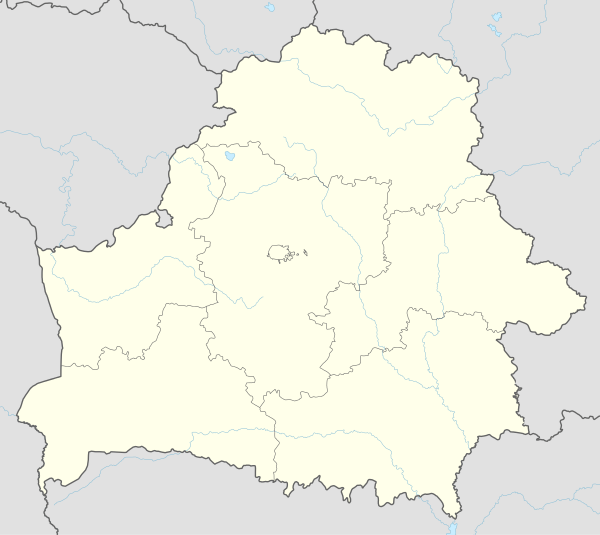
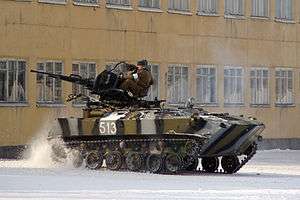
.svg.png)